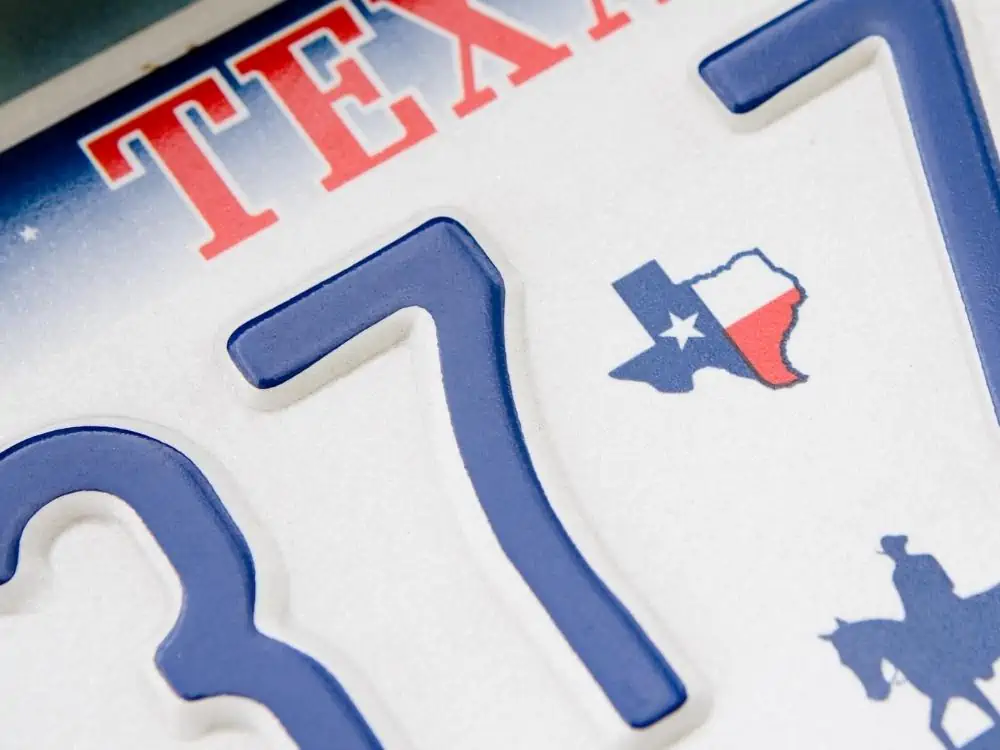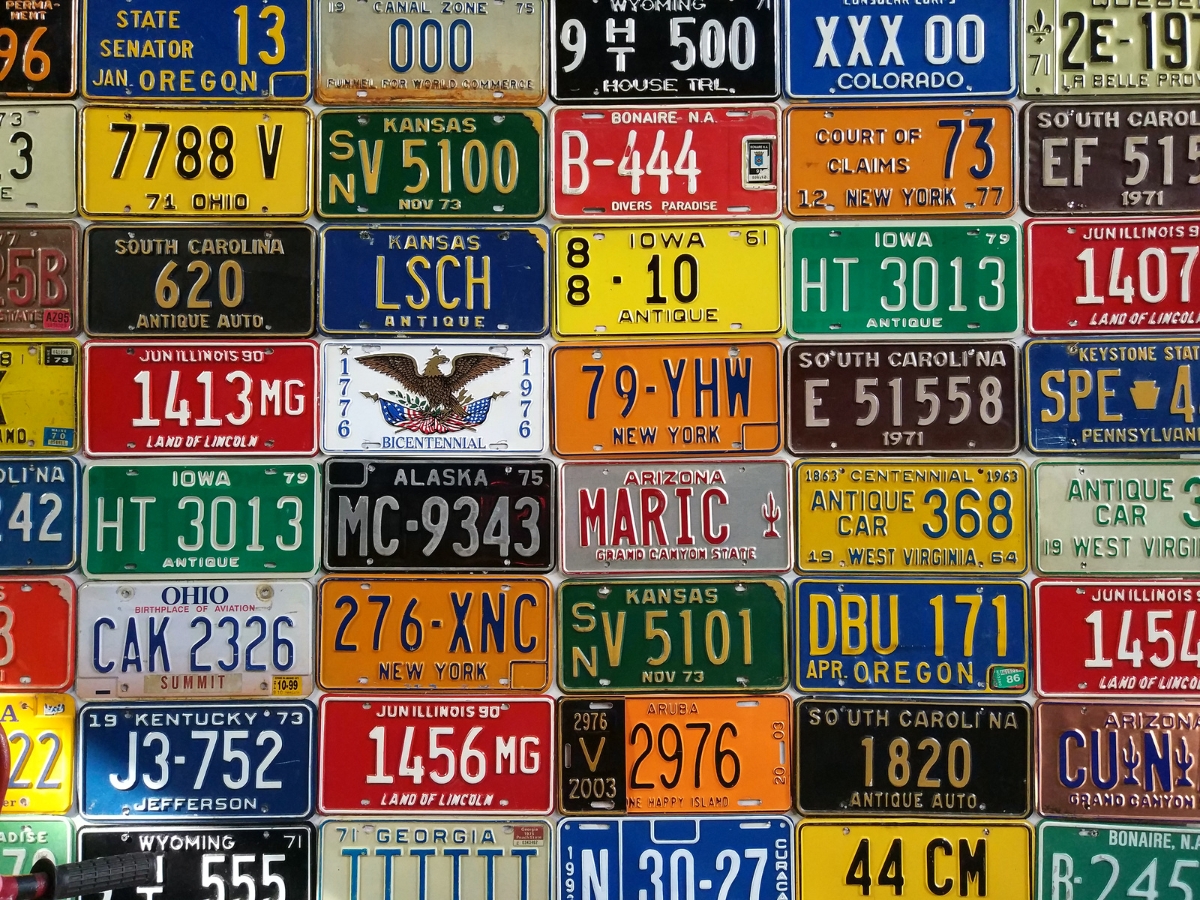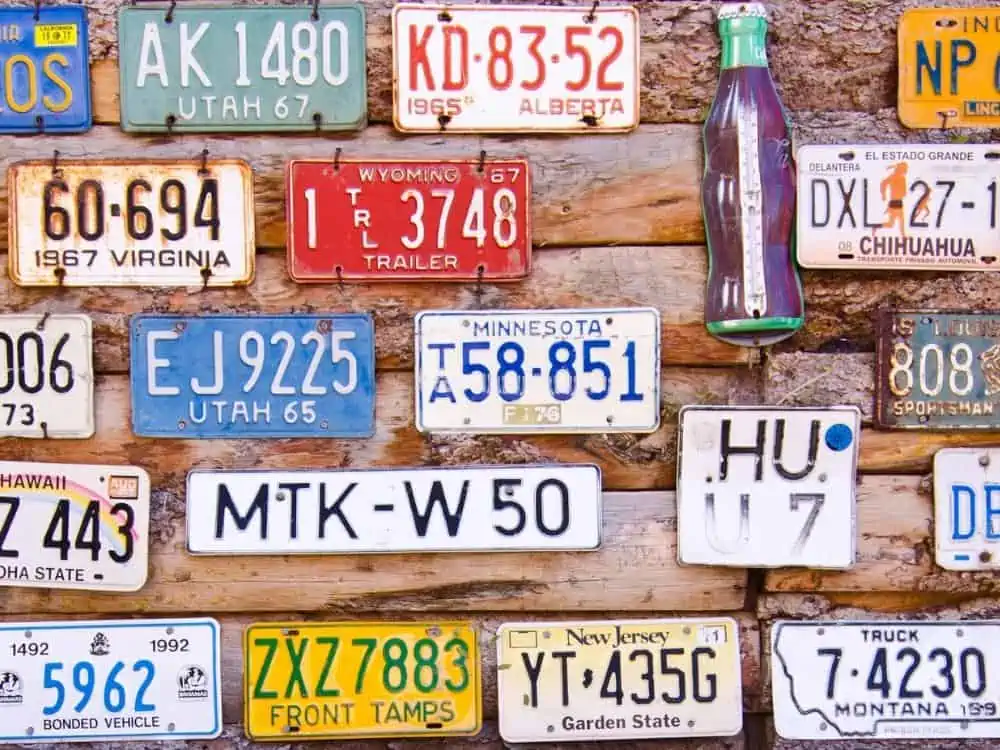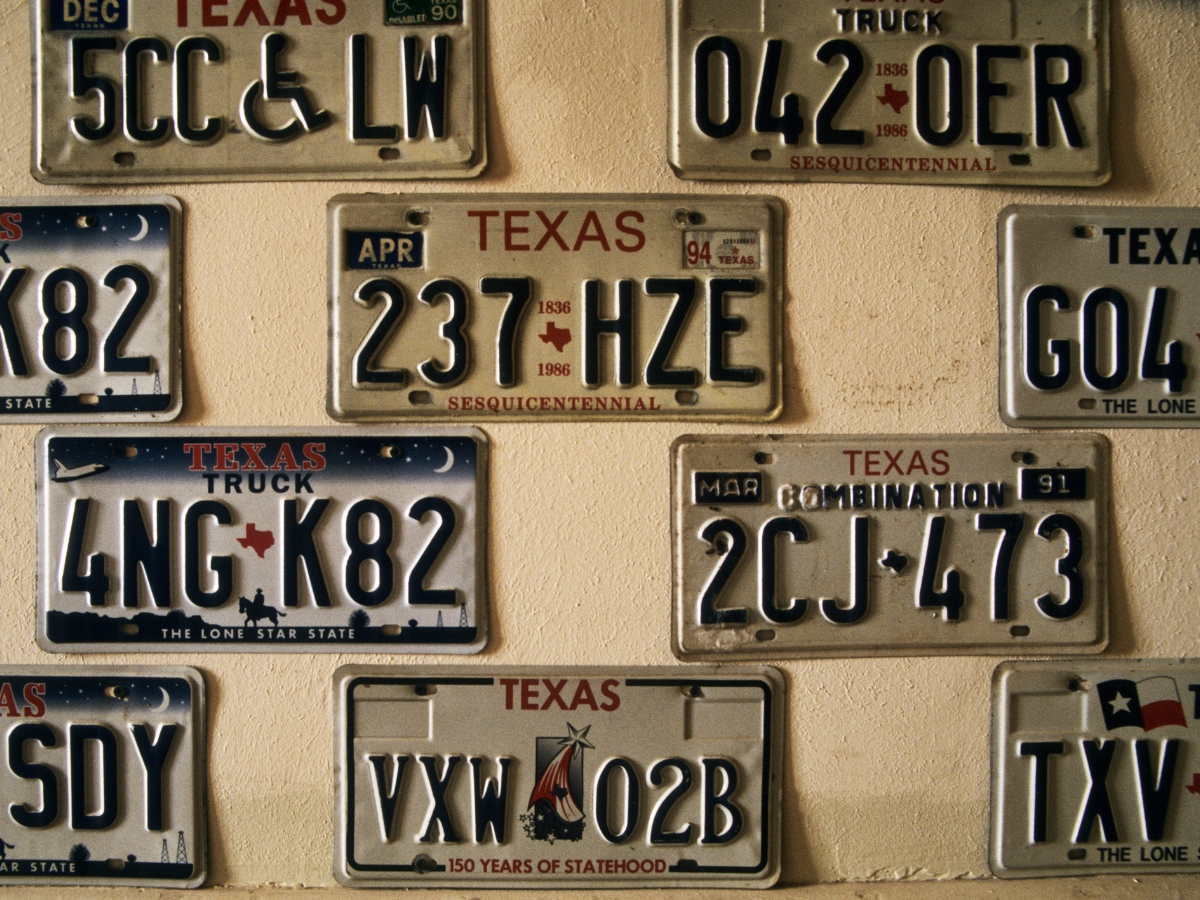Share the post "Old License Plates in Texas – Creative and Legal Options"
You are moving to a new state and must dispose of your old license plates. There are multiple things to do with unused license plates, but does Texas allow vehicle owners to keep their original plates?
Submitting a license plate to the Department of Motor Vehicles is not mandatory. However, you must notify the state of Texas and your insurance firm about a change of ownership. Here are several things to do with old license plates in Texas.
Key Points:
- Texas allows license plate transfer to a new vehicle.
- Surrendering license plates involves notifying the DMV and returning them to the county tax office.
- Old license plates can be recycled, kept as souvenirs, sold online, or upcycled into crafts.
- Contact the county tax office for surrendering license plates in Texas.

- Transferring license plates to a new vehicle:
- License Plate Specifications Table for Texas
- Surrendering License Plates
- How to Dispose of Old License Plates Texas
- Use a Recycle Bin or Recycling Facility
- Keep Your Old License Plates As A Souvenir
- Sell Your License Plates Online
- Upcycle Your Old License Plates
- License Plate FAQ
- Contact Details for Surrendering License Plates in Texas
Transferring license plates to a new vehicle:
Transferring license plates from an old vehicle to a new one in Texas is a multi-step process involving interactions with the Texas Department of Motor Vehicles (TxDMV) and your county tax office. Here’s a guide to walk you through the necessary steps:
Prerequisites
- Valid Texas Identification: You must have a valid Texas driver’s license or ID card.
- Proof of Insurance: Have valid vehicle insurance for the new vehicle.
- Proof of Ownership: Vehicle title or other proof of ownership for both the old and the new vehicle.
- Inspection Certificate: The new vehicle should have passed the Texas State Vehicle Inspection.
Steps to Transfer License Plates
- Vehicle Sale Documentation: Remove the license plates and keep all sale documentation upon selling your old vehicle.
- Notification of Sale: Use the Vehicle Transfer Notification through the TxDMV’s website within 30 days of selling the old vehicle. This is crucial for releasing your liability for the old vehicle.
- Visit County Tax Office: Take your license plates, identification, proof of insurance, and other relevant documentation to your local county tax office.
- Application Forms: Fill out the necessary forms to apply for the transfer. The most commonly used form is VTR-146, also known as the “Application for Texas Title and/or Registration“.
- Payment: Pay the required transfer fees. Fees can vary based on the type of vehicle and other factors, but typically there is a nominal fee for the transfer.
- Verification and Approval: The county tax office will verify all the documents and approve the transfer if everything is in order. Your old license plates will now be linked to your new vehicle.
- Update Insurance and Registration: Remember to update your insurance and registration details to reflect the new vehicle information after the transfer.
Optional Step
- Temporary Tags: If there is a delay in the process, you may apply for temporary tags for your new vehicle, which is valid for up to 60 days.
By following these steps meticulously, you can successfully transfer your license plates from your old vehicle to your new one in Texas. Failure to comply with any steps or provide necessary documentation can result in delays or fines, so be thorough and double-check all requirements.
License Plate Specifications Table for Texas
License plates in Texas are subject to several regulations and standards to ensure uniformity, visibility, and state compliance. Below is a table that outlines the key specifications for standard Texas license plates:
| Specification | Standard License Plate | Notes |
|---|---|---|
| Dimensions | 12″ x 6″ | Standard size for most U.S. plates |
| Material | Aluminum | Designed for durability and longevity |
| Color | Varies | Standard plates are white with black text; specialty plates have different designs and color schemes. |
| Number of Characters | 5-7 | Alphanumeric characters; varies by plate type |
| Font Style | Helvetica | Designed for readability |
| Reflective Background | Yes | Helps with visibility at night |
| Issuing Authority | TxDMV | Texas Department of Motor Vehicles |
| Validity Period | 7 years | Must be renewed upon expiration |
| Inspection Sticker Placement | None | Texas no longer requires separate inspection stickers; inspection status is checked electronically |
| Renewal | Online / In-person | Renewal can be done via the TxDMV website or at local county tax offices |
| Optional Features | Custom Text | For an additional fee, customized text may be available |
Specialty and custom plates (e.g., disability plates, veterans plates, college and university plates, etc.) may have different specifications and additional criteria for eligibility.
Before applying for a particular type of plate, it’s essential to consult the specific guidelines and requirements set forth by the Texas Department of Motor Vehicles (TxDMV) to ensure you meet all eligibility and documentation needs.

Surrendering License Plates
Surrendering old license plates in Texas is a straightforward process, but it’s essential to ensure you complete every step accurately to avoid complications. Here is an overview of the process:
When to Surrender Plates
You may need to surrender your license plates in the following situations:
- You have sold or disposed of your vehicle and are not transferring the plates to a new vehicle.
- Your plates are damaged or unreadable and you have received replacements.
- You have moved out of Texas and registered your vehicle elsewhere.
Steps for Surrendering License Plates
- Notification of Sale or Status Change: If you’ve sold or otherwise disposed of your vehicle, it’s important to notify the Texas Department of Motor Vehicles through their Vehicle Transfer Notification within 30 days to release your liability from the vehicle.
- Removal of Plates: Physically remove the license plates from the vehicle you no longer own or need to register.
- Visit Local County Tax Office: Bring the license plates you wish to surrender to your local county tax office. Some offices might require an appointment, so it’s best to call ahead.
- Required Documents: While generally not mandatory for surrendering plates, it’s a good idea to bring identification and any pertinent vehicle documentation, just in case.
- Form Filling: Complete any forms as directed by the county tax office. The requirements can vary by county.
- Surrender Plates: Hand over your old license plates to the tax office. They will provide you with a receipt acknowledging the surrender, which you should keep for your records.
- Notify Insurance: Inform your insurance company that you have surrendered your plates and no longer own the vehicle (if applicable).
Additional Considerations
- Fees: Generally, there is no fee for surrendering license plates, but certain counties might have administrative charges. Check with your local county tax office for specifics.
- Mail-In Option: Some counties may allow you to surrender plates by mail. In such cases, include a letter explaining why you’re surrendering the plates, and send them via certified mail for documentation purposes.
You should be able to properly surrender your old license plates to the Texas Department of Motor Vehicles via your local county tax office. Keeping records of the surrender can be crucial for resolving any potential issues that could arise later, such as disputes over liability or vehicle ownership.

How to Dispose of Old License Plates Texas
Disposing of old license plates in Texas involves a series of steps to ensure that they do not fall into the wrong hands and are properly rendered unusable for any illicit activity. Here is a detailed guide on how to dispose of your old license plates in the state:
Steps for Disposing of Old License Plates
- Remove Plates: The first step is to physically remove the license plates from the vehicle if you haven’t done so already.
- Surrender (Optional): If possible, surrendering the old plates to your local county tax office is the best course of action. While not mandatory, this provides a formal record of the plates being taken out of circulation.
- Damage Plates: If you opt not to surrender the plates, it’s a good practice to render them unusable by bending or cutting them. This ensures that they cannot be used illegally.
- Dispose Properly: Do not throw the plates in the trash in their original condition. Either damage them first or take them to a recycling center that accepts metal.
- Local Recycling Programs: Some localities have recycling programs for license plates. Check with your local county recycling center to see if this service is available.
- Notification: If you have not yet notified the Texas Department of Motor Vehicles (TxDMV) of the sale or status change of the vehicle associated with the plates, do so online to release your liability.
Additional Precautions
- Records: Keep any paperwork or documentation confirming the surrender or destruction of your plates. This may be useful in case any legal questions arise later.
- Insurance Notification: If you have not transferred the plates to a new vehicle, notify your insurance company that you have disposed of your old plates and, if applicable, the vehicle they were associated with.
- Confidentiality: License plates are linked to your personal information, so handling their disposal is crucial to avoid any potential data misuse.
By following these steps and precautions, you can ensure that your old license plates are disposed of in a legal and responsible manner. Failure to do so can lead to legal complications, including fines or other penalties.

Use a Recycle Bin or Recycling Facility
Recycling an old license plate in Texas comes at no cost. Cut the license plates if you think recycling is the perfect option. Make sure to cut them into tiny pieces to prevent fraudulent use of the license plates.
However, some vehicle owners recycle their plates without resizing them into small pieces. Remember, your license plate can get you into trouble because it still shows your name. State police will contact you if someone commits a crime with your license plate.
The best option would be to take your license plates to your local recycling center. Don’t forget to remove all month and year decals before disposing of your license plate.
The Department of Motor Vehicles might also recycle the old license plate for you. Mail your old license plate to the nearest DMV office. Ask for a receipt, as you can use this for tax purposes. In addition, the receipt is proof that you don’t use that license plate.
Use soap and water to prepare your license plate for recycling. You must follow all these steps before submitting your license plate for recycling.
Do Plates Go In Recycling?
License plates are made from aluminum, making them easy to recycle. Old license plates do expire, so eliminating them is vital to prevent environmental hazards.
Aluminum license plates are in demand by manufacturers seeking to reduce carbon pollution in the surrounding areas. Texas has specific requirements for different types of license plates. Be sure to check the specifications from the state website.

Keep Your Old License Plates As A Souvenir
The Department of Motor Vehicles always encourages its residents to keep their license plates as something to remember in Texas.
Keeping the license plate in your house isn’t enough. Send the plate to family members across the United States. Instances of buying unused license plates as souvenirs have increased in Texas.
Can I Keep My Texas License Plate as a Souvenir?
Texas license plates are considered perfect for Southwestern home décor. DMV will issue you with a souvenir version of any license plate. However, it’s worth noting that souvenir license plates aren’t designated vehicle registration.
Hang the License Plate on Your Garage Wall
Some people prefer hanging their license plates on garage walls when they move out of Texas. Nowadays, most residents in Texas decorate their garages with plates. It’s a tradition you can try, too.
How To Attach License Plate to Your Garage Wall
Use a thumb tack to make small holes in your garage wall. Place a magnet on the holes to hold the license plates.
Here’s a nice example of plates on a wooden wall;

Sell Your License Plates Online
Before looking for a buyer, check if the license plate is a collector’s edition. Vintage and rare license plates are expensive and might fetch you good money. There are multiple platforms to sell your license plates, such as Facebook Marketplace and eBay.
If you sell your license plate through eBay, reserve your item to ensure it sells at the best price. If you don’t like online transactions, surrender your Texas license plates to antique shops. You will find several antique shops in South Congress. Contact the antique shop and inform them you have Texas license plates.
Collectors in your neighborhood might be looking for license plates. Alternatively, visit any consignment or second-hand shop in Texas to see if your license plates are worth it.
Make sure to transfer your license plates because it protects you. Visit the county tax collector’s office, and they will help you move the license plate.
How Much Are Old License Plates Worth in Antique Shops?
You can sell your license plate for thousands of dollars. However, the price depends on factors like:
- Physical condition of the license plates
- Date of Manufacturing
Collectors spend a lot of time online looking for license plates. Amateur plate collectors pay attention to online sites such as eBay to determine the price of license plates.
Donate the License Plate
If you think your license plate isn’t worth it, you can donate it. Donate the plate to your artist friend or a collector who makes a living selling and buying license plates. Thrift shops and art studios might appreciate your donation.

Upcycle Your Old License Plates
People who choose not to recycle license plates can upscale them. The most popular ways to upcycle your license plates include birdhouse and wall clocks. Rearrange letters on your plate and come up with creative signs.
Ensure to observe safety precautions when handling rusty license plates. Although it’s easy to bend aluminum, the plate might have sharp edges. You will have an easy time managing your project with the right tools.
You can create a bird feeder using your license plate. Sell the final product on your online shop or Pinterest. Design a Christmas tree advent calendar for the holiday season. After finishing your DIY project, gift your friends or parents when you visit for Christmas.
License Plate FAQ
Here are the most common questions on what to do with old license plates in Texas.
Is it legal to sell old license plates in Texas?
Texas allows vehicle owners to sell their old license plates. You can sell your license plate on various marketplaces like Craigslist and eBay. However, comply with Department of Motor Vehicle regulations, preventing the buyer from using your plate fraudulently.
What can you do to dispose of your old license plate in Texas?
Return your old license to the Department of Motor Vehicles through mail or appointment. You can also cut your license plate and put it in the trash.
Contact Details for Surrendering License Plates in Texas
Contacting the appropriate offices for surrendering license plates in Texas usually involves contacting your local county tax office, as they handle most vehicle registration matters. Here are a few ways to find the contact details for surrendering license plates:
Online Directory
- TxDMV Website: The Texas Department of Motor Vehicles maintains a list of county tax offices. You can search for your county to find the contact details: TxDMV County Tax Offices
Phone Directory
- Statewide Customer Service Center: You can contact the statewide TxDMV Customer Service Center at 1-888-368-4689 for general information and for directions to your local county tax office.
Local Government Resources
- County Websites: Many counties have their own websites with tax office contact details. These sites often provide phone numbers, office hours, and sometimes email addresses.
In-Person Visit
- County Tax Office: If you are in or near the county where your vehicle is registered, you can visit the tax office to obtain this information.
Social Media and Other Platforms
- Local Government Social Media: Some counties may have social media platforms where you can message them directly for information.
Other Channels
- Email and Fax: Some county tax offices provide email addresses and fax numbers for more detailed inquiries.
Before reaching out, gather all pertinent information about your license plates and vehicle registration. This will help make the process smoother. It’s also a good idea to confirm the operating hours for phone lines or in-person visits, as these can vary by location.
Note that due to the high volume of inquiries, there may be waiting times when contacting these offices, especially via phone. Plan accordingly to avoid any inconvenience.
Share the post "Old License Plates in Texas – Creative and Legal Options"
Christian Linden is a seasoned writer and contributor at Texas View, specializing in topics that resonate with the Texan community. With over a decade of experience in journalism, Christian brings a wealth of knowledge in local politics, culture, and lifestyle. He holds a Bachelor's degree in Communications from the University of Texas. When he's not writing, Christian enjoys spending weekends traveling across Texas with his family, exploring everything from bustling cities to serene landscapes.











